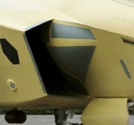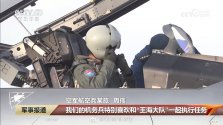How many blocks or batches of J-20 are there, and how do they differ if so.
You are using an out of date browser. It may not display this or other websites correctly.
You should upgrade or use an alternative browser.
You should upgrade or use an alternative browser.
J-20 5th Gen Fighter Thread VIII
- Thread starter Blitzo
- Start date
How many blocks or batches of J-20 are there, and how do they differ if so.
Do you actually expect information like that to be knowable to the public?
Before asking questions, it is probably a good idea to first ask "is my question realistic".
Since we're on the topic, I remember hearing from some really shady post that the J-20 DSI inlets could be made out of a radar transparent material with a L/O structure underneath. I've never seen any other source for this so it's almost definitely made up, but if there's anyone else that has seen this claim with some evidence, I'd love to see it.Is that "ribs" on the DSI? what if those ribs can move to form new shape?
Since we're on the topic, I remember hearing from some really shady post that the J-20 DSI inlets could be made out of a radar transparent material with a L/O structure underneath. I've never seen any other source for this so it's almost definitely made up, but if there's anyone else that has seen this claim with some evidence, I'd love to see it.
Why would you make the DSI bumps out of radar transparent material? It helps block the engine fan blades and if it were transparent then it would fail its job.
At the risk of giving that claim more credibility, the DSI bumps are not optimal for RCS and could conceivably fit a more optimal structure that still blocks the bladesWhy would you make the DSI bumps out of radar transparent material? It helps block the engine fan blades and if it were transparent then it would fail its job.
You have a lost of internal volume with that option and probably weight, It's hard to know anyway... a lot of different stuff to optimize on a fighter jet, the gain on one aspect is a lot of time a lost in another.Most (but not all) of the DSI bump is covered with what appears to be radar transparent composite materials. It would make sense that the radar transparent composite material on the surface of the DSI bump is shaped to optimize airflow while the underneath structure is optimized for L/O.
View attachment 124897
The profit margin of China's military products is controlled within 5% by the state
This may be accurate for the Chinese equivalent of the 'primes' (AVIC etc) but not the case for component suppliers.
Exhibit A:
Huaqin Technology, Ticker: 688281, states on its Annual Report that it is a manufacturer of stealth coatings. While I can only speculate whether it is indeed the supplier for J-20 (I have no clue), I am reasonably certain it manufactures products for the PLA as it is a military supplier.
The company made 512mln/672mln of revenues in 2021/2022, respectively; And made 233mln/333mln of net income over the same period, respectively, representing a net income margin of 46% and 49%, respectively.
The sums are pretty trivial so this particular example isn't much cause for concern, but in principle excessive profitability is a market signal that a sector is in need of competition. AVIC should put out tenders for other stealth coating suppliers.This may be accurate for the Chinese equivalent of the 'primes' (AVIC etc) but not the case for component suppliers.
Exhibit A:
Huaqin Technology, Ticker: 688281, states on its Annual Report that it is a manufacturer of stealth coatings. While I can only speculate whether it is indeed the supplier for J-20 (I have no clue), I am reasonably certain it manufactures products for the PLA as it is a military supplier.
The company made 512mln/672mln of revenues in 2021/2022, respectively; And made 233mln/333mln of net income over the same period, respectively, representing a net income margin of 46% and 49%, respectively.
Either this company invests more of its profits into R&D to defend its share, or it cuts prices, or a competitor provides a superior product. Whatever the case, the outcome will be better coatings at lower prices.


